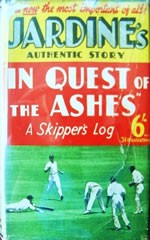In Quest of the Ashes
Martin Chandler |Published: 1933
Pages: 292
Author: Jardine, Douglas
Publisher: Hutchinson
Rating: 3.5 stars

It is more than 75 years since the Bodyline Series took place in the Australia summer of 1932/33, and more than 50 years since the death of the English captain, Douglas Jardine, yet there is a section of the cricket loving public that seems to have an unquenchable appetite for information about the series, 2009 having seen the release of the 20th full length book devoted to the tour (Michael Arnold’s “Bodyline Hypocrisy”).
“In Quest of the Ashes” was first published soon after the English team returned from the tour. It should be borne in mind by anyone reading the book now that it was written on the basis that those who purchased it would have seen none of the actual play other than a few fragments on the newsreels at the cinema. Given the furore that surrounded the series there can be little doubt that anyone who read this book in isolation, then or now, would have been left wondering just what all the fuss was about.
Jardine begins with a short history of and explanation of leg theory bowling. He goes on to look at the issues faced by the selectors in picking the touring party and then proceeds to a detailed account of each of the five Test matches. There is a very thorough and unusually presented statistical section to conclude the book. Also present is a chapter on Jardine’s favourite form of relaxation, fly fishing, the presence of which this reviewer cannot help but think is an example of Jardine’s much vaunted dry sense of humour and is his way of suggesting to his readers that far too much fuss was made about a mere cricket tour.
The importance of Jardine’s account lies in the way that he sets out the reasoning behind his tactical decisions. He is always ready to point out where, with the benefit of hindsight, he feels that mistakes were made and, while many tales have been told and retold about problems between him and certain members of the touring party in relation to matters of team selection, Jardine sets out sound cricketing reasons for each change of personnel that took place. Additionally while the book is in no way autobiographical Jardine’s personality does come clearly through in his writing and the fact that it does is the other, to modern readers at least, great quality that the writing has.
As far as Jardine’s supposed loathing of Australia and all things Australian is concerned it is difficult not to come to the conclusion that history has exaggerated that somewhat. That there was a mutual antipathy between Jardine and the average partisan Australian spectator cannot be doubted and the one point in this book where Jardine is prepared to court controversy is in his condemnation of the behaviour of sections of the crowds that he encountered. That said whatever his feelings in private might have been his writings are both gracious and complimentary towards the Australian players.
The interest of successive generations of cricket lovers in Jardine’s thoughts on the series is illustrated by the fact that the book has, uniquely amongst tour accounts, been published on three separate occasions. The first edition, despite competition from books by, amongst others, Harold Larwood, Jack Hobbs and Arthur Mailey, must have sold well as copies at reasonable prices turn up regularly on the second hand market. A second edition, published in 1982 by Orbis, contains the original book in its entirety together with a new introduction by John Arlott. The third edition hit the shelves in 2005. It seems likely that the publishers of that edition, Methuen, were somewhat caught out by England’s remarkable success that summer and that their intention of producing a book harking back to days when England did win the Ashes was rather scuppered by Michael Vaughan’s team’s memorable performance. For the non-collector that most recent edition is undoubtedly the best purchase containing as it does a new foreword by another highly regarded England captain, Mike Brearley, and, more interestingly still, an afterword by Fianach Jardine, one of the great man’s four daughters.
Overall if what is sought is a comprehensive and unbiased account of the Bodyline Tour then it would be sensible to seek out a copy of David Frith’s “Bodyline Autopsy” or, from a previous generation, Laurence Le Quesne’s “Bodyline Controversy”. For anyone who does that and then wishes to know more then this book is highly recommended.






Leave a comment